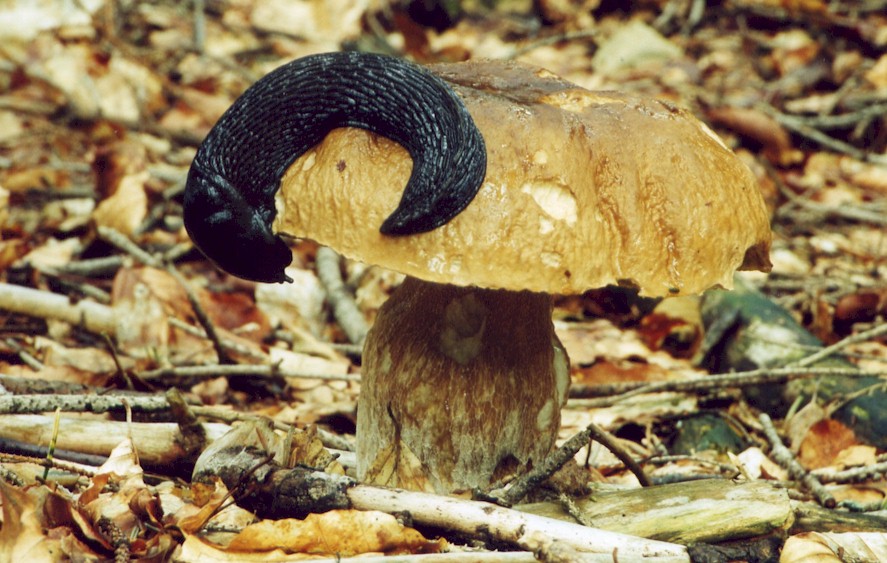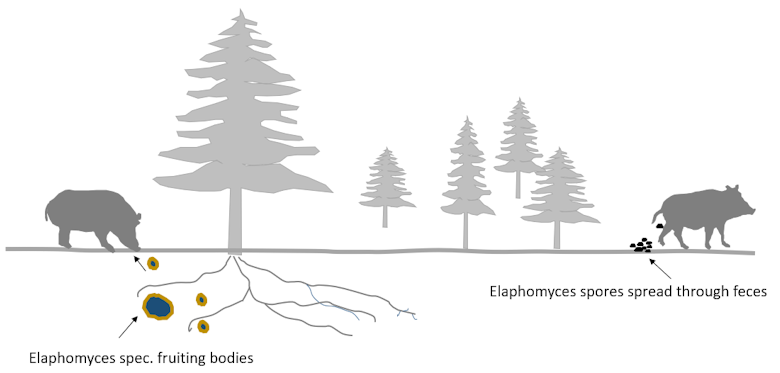Evolution has produced partly complex strategies of how organisms reproduce. In the case of fungi, there are various ways in which spores can be spread. One of these is called mycophagy (mykos = fungus, phagie = eat) or fungivory. What is it all about? The term mycophagy is applied to animals that eat fungi, ultimately spreading spores in the environment. This habit is widespread, and vectors include birds, invertebrates, mammals, and even turtles. Figure 1 shows a snail feasting on a young porcini mushroom.

Many studies on mammals and mycophagy involve hypogene species that lack mechanisms of spore discharge and depend on external vectors to distribute their spores. Therefore, mycophagy is important not only to these mammals as a food source, but also to forest ecosystems, as the process of mycorrhiza transports fungi to new tree roots, indirectly influencing succession
Observations of mammalian mycophagy have been recorded since at least 1800. Rees and Fisch (1887) addressed the dispersal of Elaphomyces (deer truffle) spores by animals (both wild and experimental) and concluded that spores pass unchanged through the gastrointestinal passage animals
The fungivorous or mycophagous diet of small mammals, especially those weighing less than three kilograms, is well documented in the literature, and reliance on fungi as a food resource can vary greatly among species. Mammalian mycophagy has been reported for centuries and most records are from North America and Australia, but there are also records from Europe.
Mycophagous strategies of animals
The figure 2 shows a wild boar searching for deer truffles. The truffles, mostly Elaphomyces granulatus, are eaten very readily by wild boars. The spores pass largely unharmed through the gastrointestinal tract and later return to the soil surface via feces. With the precipitation and via decomposition processes, the spores then reach deeper into the supporting humus. Since feral pigs travel an average of about 4 km per day (Keuling and Stier 2006), the spores are thus distributed throughout the ecosystem.
Fig. 2: Mycophagy by wild boar: the deer truffles taken as food are digested and the spores are distributed in the environment through the feces
A key function of hypogeous fungi is the role their fruiting bodies play as a food source for a large number of terrestrial mammals. For a few animals, hypogaeal fungi form the major dietary component year-round, while for others they have only seasonal or supplemental value. The extent to which fungal parts are the diet of mammalian species is reflected in the different levels of adaptation to find and digest these nutritionally demanding forages.
Trappe and Claridge (2005) categorized mycophagists as:
(1) obligate – completely or almost completely dependent on fruiting bodies.
(2) Preferential – preferring fruiting bodies over other food sources
(3) incidental or opportunistic – occasionally eat fruiting bodies when available
(4) Accidental ingestion of fruiting bodies or spores when ingesting other food items
Literature
Katharina Kräutler, 2009: Extraktion und Amplifikation von Pilz-DNA aus Kleinsäugerkotprobe. Link
Keuling =., Stier N., 2006: Schwarzwild – Untersuchungen zu Raum- und Habitatnutzung des Schwarzwildes (Sus scrofa L. 1758) in Südwest-
Mecklenburg unter besonderer Berücksichtigung des Bejagungseinflusses und der Rolle älterer Stücke in den Rotten
Piattoni, F., Ori, F., Morara, M., Iotti, M., Zambonelli, A., 2012. The role of wild boars in spore dispersal of hypogeous fungi. Acta Mycol. 47, 145-153. Link
Rees M., und Fisch C., 1887: Untersuchungen über Bau und Lebensgeschichte der Hirschtrüffel, Elaphomyces.
Soteras et al 2017: Mycophagy by invasive wild boar (Sus scrofa) facilitates dispersal of native and introduced mycorrhizal fungi in Patagonia, Argentina. Link
Trappe J.M., Claridge A.W. 2005: Hypogeous fungi: evolution of reproductive and dispersal strategies through interactions with animals and mycorrhizal plants. (In:) J. Dighton, J.F. White, P. Oudemans (eds). The Fungal Community. 3d.: 613–623. Link

